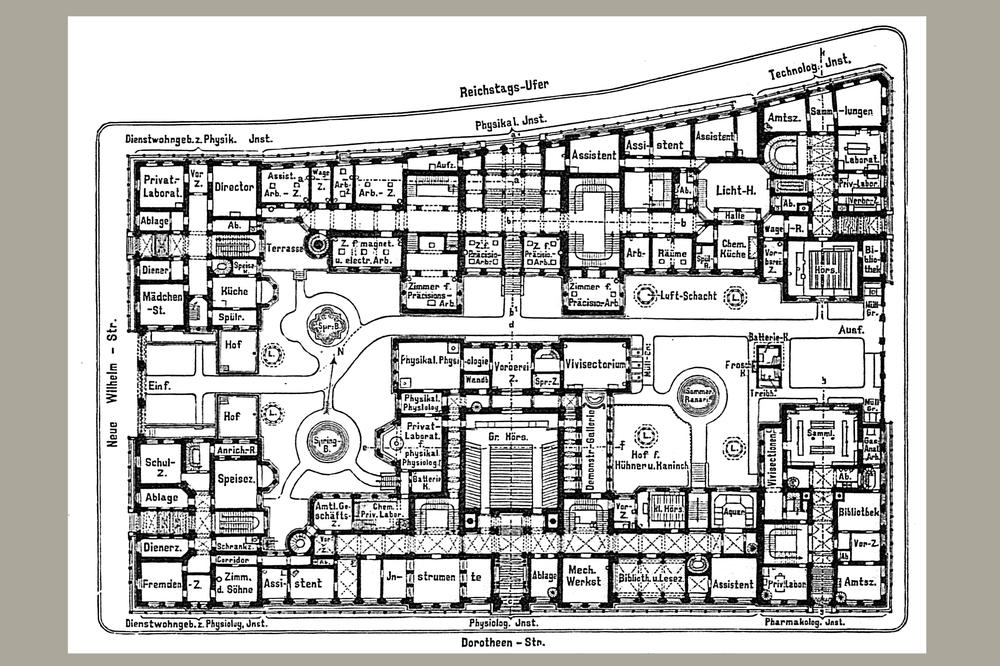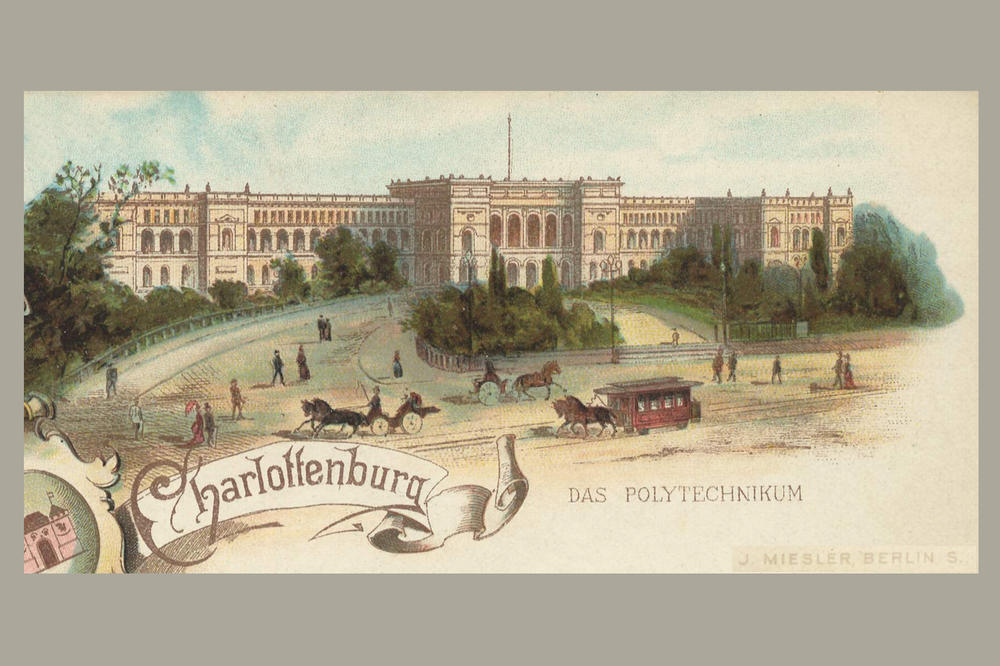University in the City
The exhibition “Architekturen der Wissenschaft” shows how academic buildings have shaped Berlin’s cityscape.
Jul 12, 2018
In the 19th century, Berlin University moved into the Prinz-Heinrich-Palais, directly adjacent to the Neue Wache, which is still today the main building of Humboldt-Universität.
Image Credit: Humboldt-Universität zu Berlin
A yard for chickens and rabbits and a room for magnetic and electrical work, a girls’ room, and a private laboratory – all in the immediate vicinity and under one roof. Built in the years 1873 - 1883 between Reichstags-Ufer and Dorotheenstraße, the floor plan of the complex for natural sciences illustrates how research was carried out at the end of the 19th century. Comprising an entire block, the building housed four institutes. To get to a chemical laboratory from the private rooms, in which the leading scientists lived with their families, for example, they only had to cross a corridor – and only a few corridors further to communicate with a colleague in the vivisectorium about a prepared laboratory animal. The floor plan is one of Gabriele Metzler’s favorite objects; a professor of Western European history and transatlantic relations at Humboldt-Universität, she curated a small but detailed and informative exhibition on the history of Berlin’s university and science buildings together with the habilitated science historian Arne Schirrmacher. It shows how urban and university development have been intertwined since the beginning of the 19th century.
The huge complex of buildings in a prime location in the immediate vicinity of the Reichstag tells of the rise of the natural sciences as leading disciplines at the end of the 19th century, but also of the “division of labor in research” and the “connection between science and life,” explains Gabriele Metzler. Today, as the Robert-Koch-Forum, it houses the Einstein Center Digital Future, a joint institution of the three major universities in Berlin. The part on the banks of the Spree River that was destroyed in the war was replaced by ARD’s recently built capital city studio.
The floor plan of the building complex for the natural sciences shows which institutes were located between Reichstags-Ufer und Dorotheenstraße.
Image Credit: Physikalisches Institut, Reichstagsufer, Grundriss, AIV, Archiv Berlin und seine Bauten
Initially, however, Berlin University had no buildings of its own. “It was customary for universities to be housed in abandoned monasteries or aristocratic palaces,” says Gabriele Metzler. This was also the case in Berlin, where the university moved into the Prinz-Heinrich-Palais, still today Humboldt-Universität’s main building, which was not extended until the 20th century when two wing buildings were added on its northern side. But it didn’t take long before the scientists needed more room. As nobody wanted to share the buildings with their colleagues in the chemistry department, things soon began rolling. “The experiments were dangerous, and you could smell fumes through the whole building,” says the professor. Given new laboratories barely 100 meters away in Georgenstraße, the chemists moved out of Unter den Linden.
The large representative buildings that were erected across Europe at the end of the 19th century bear witness to the growing self-confidence of universities as academic institutions. The postwar sober façade of Technische Universität’s main building still hides today parts of Charlottenburg’s polytechnic institute, for example, which had been built between 1878 and 1884, during the founding years of science: in the capital of the newly founded German Reich, research and technology staged themselves as engines of social progress.
“Monumental main buildings demonstrate the universities’ claim of influencing society.”
The exhibition, which was created to mark the European Year of Cultural Heritage, also builds bridges to other European metropolises. “During this period, monumental main buildings were built in many cities, such as the Eidgenössisches Polytechnikum in Zurich and the main buildings of the universities in Vienna and Strasbourg,” says Gabriele Metzler. “They demonstrate the universities’ claims of influencing society and their desire to be seen.”
By the latest at the turn of the century, the space in Berlin’s center had become scarce, and – represented by the science policy maker Friedrich Althoff, among others – the idea of relocating the university to the city’s outskirts came into being. Dahlem was named for this. But the scientists did not want to move, Gabriele Metzler explains. They wanted to remain “anchored in the city center.” Freie Universität was not founded in Dahlem, for political reasons, until 50 years later. “It was able to take over parts of the buildings belonging to the Max Planck Society and establish itself in villas.” In the 1960s, new buildings were also built here, such as the “Rostlaube,” a modular, light, and deliberately anti-representative architecture designed by Parisian architects Candilis Josic Woods.
During the GDR, Humboldt-Universität was thinking about moving to Blumberg, near Ahrensfelde, or to Adlershof. Gabriele Metzler says that the fact that this project was only partially realized with a move of the natural sciences and only after 1989 was probably also due to the influence of the secret police, which maintained a guard regiment in Adlershof and vetoed the relocation plans of Humboldt-Universität.
The representative polytechnic in Charlottenburg, built between 1878 and 1884, testified to the growing self-confidence of universities as academic institutions.
Image Credit: Wikipedia Zeno-org ID number 20000570788
Whether in Dahlem, Charlottenburg, or Mitte, Berlin’s universities have always remained part of the city. Scientists in Berlin still carry out research in villas, office buildings, companies, and ministries. The idea of a campus university never caught on. In the 1930s, however, the National Socialists devised plans for reconstruction to transform Berlin into the “Reich’s capital of Germania” and, based on a Roman model, wanted to build a science city near the Olympic Stadium, says Gabriele Metzler. “Knowledge as the gateway to the city.” But the war prevented this gigantomaniac plan; numerous academic buildings, including the main building of Humboldt-Universität, were either damaged or destroyed.
“Today, we are seeing two new developments: highly technical functional buildings and spectacular buildings, often designed by star architects.”
And how do science buildings shape the cityscape today? “Today, we can see two new developments,” explains Gabriele Metzler, who, together with Arne Schirrmacher is also preparing an architectural guide through Berlin’s science districts. On the one hand, highly technical functional buildings are being created and, on the other hand, “solitaires” for which star architects are desired. These have included the spectacular library buildings designed by Sir Norman Forster, such as the Philological Library at Freie Universität, the Grimm Center designed by Max Dudler, and also Rhoda-Erdmann-Haus, nicknamed “Grüne Amöbe,” at the Institute of Biology at Humboldt-Universität on the grounds of Charité in Mitte, which was only opened two years ago. The building does not even try to gracefully integrate itself into the city, says the professor, but for exactly this reason it has an enormous effect. Science is something that still remains visible in Berlin.
Further Information
„Architekturen der Wissenschaft. Die Universitäten Berlins in europäischer Perspektive“
The exhibition at Humboldt-Universität zu Berlin
Until 30 july 2018, „Kommode“, Bebelplatz, Faculty of Law, Humboldt-Universität zu Berlin. Opening hours monday to friday, 9 am - 6 pm.
The exhibition at Technische Universität Berlin
From 23 november 2018 to 27 january 2019, monday to friday, 9 am - 6 pm. Technischen Universität Berlin, main builduing, Lichthof, Straße des 17. Juni 135, 10623 Berlin.



